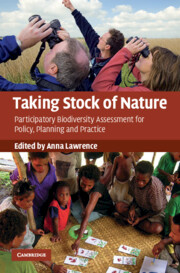Book contents
- Frontmatter
- Contents
- List of contributors
- Acknowledgements
- 1 Introduction: learning from experiences of participatory biodiversity assessment
- 2 Monitoring and assessment of biodiversity under the Convention on Biological Diversity and other international agreements
- 3 The Millennium Ecosystem Assessment: a multi-scale assessment for global stakeholders
- 4 Conservation of biological diversity in El Salvador shade coffee: the importance of taxonomic capacity for participatory assessments
- 5 Taking stock of nature in species-rich but economically poor areas: an emerging discipline of locally based monitoring
- 6 Researching local perspectives on biodiversity in tropical landscapes: lessons from ten case studies
- 7 Participatory resources monitoring in SW China: lessons after five years
- 8 Forest inventory in Nepal – technical power or social empowerment?
- 9 Perceptions of landscape change in British Columbia's Northwest: implications for biodiversity and participatory management
- 10 How thousands planned for a billion: lessons from India on decentralized, participatory planning
- 11 Inside monitoring: a comparison of bird monitoring groups in Slovenia and the United Kingdom
- 12 The personal and political of volunteers' data: towards a national biodiversity database for the UK
- 13 Improving forest management through participatory monitoring: a comparative case study of four community-based forestry organizations in the Western United States
- Index
- References
10 - How thousands planned for a billion: lessons from India on decentralized, participatory planning
Published online by Cambridge University Press: 06 December 2010
- Frontmatter
- Contents
- List of contributors
- Acknowledgements
- 1 Introduction: learning from experiences of participatory biodiversity assessment
- 2 Monitoring and assessment of biodiversity under the Convention on Biological Diversity and other international agreements
- 3 The Millennium Ecosystem Assessment: a multi-scale assessment for global stakeholders
- 4 Conservation of biological diversity in El Salvador shade coffee: the importance of taxonomic capacity for participatory assessments
- 5 Taking stock of nature in species-rich but economically poor areas: an emerging discipline of locally based monitoring
- 6 Researching local perspectives on biodiversity in tropical landscapes: lessons from ten case studies
- 7 Participatory resources monitoring in SW China: lessons after five years
- 8 Forest inventory in Nepal – technical power or social empowerment?
- 9 Perceptions of landscape change in British Columbia's Northwest: implications for biodiversity and participatory management
- 10 How thousands planned for a billion: lessons from India on decentralized, participatory planning
- 11 Inside monitoring: a comparison of bird monitoring groups in Slovenia and the United Kingdom
- 12 The personal and political of volunteers' data: towards a national biodiversity database for the UK
- 13 Improving forest management through participatory monitoring: a comparative case study of four community-based forestry organizations in the Western United States
- Index
- References
Summary
As a signatory of the Convention on Biological Diversity, India is obliged to produce a National Biodiversity Strategy and Action Plan (NBSAP). The broad purpose of the NBSAP process was to produce an action plan to help conserve India's unique biodiversity, facilitate the sustainable use of biological resources, and ensure the equitable sharing of benefits from this use. Moving away from the conventional top-down method whereby a group of experts is appointed to write the plan, the process of developing the NBSAP was intended to be transparent and participatory, accommodating points of view from diverse interest groups such as village level organizations and movements, NGOs, academicians and scientists, government officers from various line agencies, the private sector, the armed forces and politicians. The thinking behind this was that since biodiversity affects all of society, as many people as possible from a wide range of social sectors should be offered the opportunity to contribute to planning for its conservation.
The core group, appointed by the Ministry of Environment and Forests, Government of India (MoEF, GoI), to co-ordinate the process, made a conscious attempt to move away from the dominant trend of centralized planning. Several thousand people, spread all over the country and from different walks of life and backgrounds, including women and men from local communities, were involved in participatory planning at local, state and national levels, and used flexible and innovative methodologies for preparing strategies and action plans.
- Type
- Chapter
- Information
- Taking Stock of NatureParticipatory Biodiversity Assessment for Policy, Planning and Practice, pp. 211 - 231Publisher: Cambridge University PressPrint publication year: 2010
References
- 1
- Cited by

